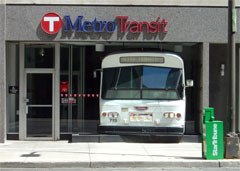Eat Your Own Blog Feeds
Many of you reading this are using a feed reader, where you aggregate many blog feeds and read them together. As a blog writer, I want to make my feed available to anyone who wants to read it. However, many people don’t realize that you can utilize your own blog feed for yourself, and not just to read your own posts.
Making your blog feed available on Web sites is way to draw new readers to your blog. You may have seen widgets that you can place on a Web site to share with readers your latest blog feeds. Where widgets work well in many cases, with some extra effort, namely some server-side Web scripting, you can use you part or all of your feed and control its presentation.
One of my clients is River Junction Press, the publisher of the book Lewis and Clark Road Trips, a great book on heritage travel along the trail Lewis and Clark took over 200 years ago. When we developed the Web site the author, Kira Gale, wanted to make her blog posts available on the Web site. On the home page of the Web site, we display the first paragraph of the 3 most recent blog posts. The blog itself is an option in the tab navigation at the top, and Web site visitors will get a taste of the blog, and links to it, right on the home page.
This was achieved using ColdFusion scripting, the language the Web site was developed in, plus the same style sheet for the Web site. This can be done with any other language that allows you to process an XML file. Looking at the Web site home page, does it look like there’s blog content there, other than the heading? That is the beauty of RSS!
Technology • (0) Comments • PermalinkWhat is RSS?
Hello reader! You may be reading this blog post after visiting thehotiron.com or using a feed reader, whether on a computer or mobile device. If you are using the latter, how did it get there? And if you are the former, you may be asking what a feed is.
This video on RSS by Commoncraft has been in circulation for several months, but is still current, on how RSS works. If you haven’t seen it already, it is good for everybody.
Technology • (2) Comments • PermalinkHow Much Is Your Blog Worth?
 After being declared a low-rank nerd, I was suspect to trying any other Web site “calculators” that make generalizations on a subset of data. After re-reading that opening sentence, my apologies to political pollsters.
After being declared a low-rank nerd, I was suspect to trying any other Web site “calculators” that make generalizations on a subset of data. After re-reading that opening sentence, my apologies to political pollsters.
Domain name guru Frank Schilling wrote on this calculator of the worth of your blog which is based on Technorati data. Only this week I created a Technorati account, to right away find I had an authority of 15 without even trying. So I gave it a try, and I found The Hot Iron is worth $8,468.10. For a blog that I started in January of this year and with rough calculations of the amount of time I spent on writing just over 100 posts, I’d say that is not a bad return.
Not that I am actively selling my blog. And just like those real estate reality shows there could be more to do to simply pump up the value of my blog. However my commitment is to my community – now and in the future.
Domain Names • Technology • (3) Comments • PermalinkUsability and Public Transportation
 Though I am not an über guru of usability, over the last 20 years of software development I have picked up a few tricks and lessons (many the hard way, the best way to learn) on how useful what you see on your computer screen is and can be. Many times it is familiarity what makes something usable – if you have seen something like it before, the learning curve should be less. And I don’t mean stealing a Web site’s design; think of how most Windows applications start with the first drop down menu being “File” and you’re onto my train of thought.
Though I am not an über guru of usability, over the last 20 years of software development I have picked up a few tricks and lessons (many the hard way, the best way to learn) on how useful what you see on your computer screen is and can be. Many times it is familiarity what makes something usable – if you have seen something like it before, the learning curve should be less. And I don’t mean stealing a Web site’s design; think of how most Windows applications start with the first drop down menu being “File” and you’re onto my train of thought.
Speaking of trains, I made a few observations first-hand involving public transportation in Minneapolis. The first was positive, the second threw me in for a loop. I will talk about the great one here, the second one I will save for a post on secret shoppers.
The bus and light rail system in the Twin Cities is called Metro Transit. The accompanying photo shows their name and logo, a letter T centered in a circle. This was extremely familiar to me, growing up in Massachusetts and living in Boston for many years. The Massachusetts Bay Transportation Authority, or MBTA, is called the T, and has a similar logo. In Twins county, the circle is red, and in Red Sox country, the circle is black.Having similar public transit logos helped me identified light-rail stations and bus stops. And if my memory is correct, I believe Pittsburgh has a similar logo. What if every public transit system in the US had a common symbol, similar to how most parking lots are identified by a blue background and white letter “P” by the entrance? Or in the world? It would make using public transit that much easier, as you could identify what and where it is. It is only buses and trains, how hard should it be?
Perhaps living in Chicago and learning its transit system and struggling with its inconsistent signage over the last few years had some input into this thought?
Technology • (4) Comments • PermalinkNext Likemind coffee on June 15
 The next likemind will be tomorrow Friday, June 15 in 25 cities around the world. In Chicago, it will be at Intelligentsia Coffee,, 53 E. Randolph, at the corner of Wabash.
The next likemind will be tomorrow Friday, June 15 in 25 cities around the world. In Chicago, it will be at Intelligentsia Coffee,, 53 E. Randolph, at the corner of Wabash.

